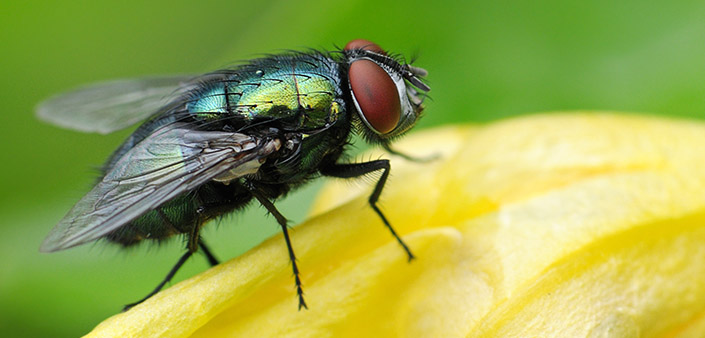Benefits of Using Our Service
- SmellGREEN® Natural Insect Repellent, Non-Toxic, Repels Rapidly Mosquitoes (Midges), Fleas, Louse & Other Biting Insects
- Aquatain AMF Liquid Mosquito Film™, Non-Dangerous, Non-Toxic, Prevents Mosquito Larvae from Breathing & Female Mosquitoes from Depositing Their Eggs on The Water Surface
- SafePRO® Mosquito Misting System with Natural Insect Repellent, 500 ft Long Misting Barrier Creates an Effective Mosquito-free Zone
- Starkeys® Outdoor Waterproof Insect Killers and Indoor Sticky Pad Units, Eco-friendly Solutions for Insect Control without The Use of Toxic Pesticides
- Solar Trap™ Solar Power Outdoor Insect Trap, Clean Energy Helps to Reduce The Emission of CO2 Gas, Environmental Friendly and Energy Saving
Flies
Flies belong to the order Diptera and are characterized by having onlt one pair of wings. The hind wings are vestigial and represented by two short organs known as halteres that serve to balance the fly during flight.
Most commonly encountered flies have large compoud eyes and usually three simple eyes. Their mouth-parts are of the sponging/lapping or piercing/sucking type.
Management
Structure
Sanitation Practices
Regular removal (at least once a week) and disposal of organic waste, including dog feces and rotting fruit, reduces the attractiveness of the area to adult flies and limits their breeding sites. Garbage should not be allowed to accumulate and should be placed in plastic bags and held in containers with tight-fitting lids. Garbage should also be placed as far from a building entrance as is practicable. In general, poor exclusion and lack of sanitation are the major contributors to fly problems.
Garbage should not be allowed to accumulate and should be placed in plastic bags and held in containers with tight-fitting lids. Garbage should also be placed as far from a building entrance as is practicable. In general, poor exclusion and lack of sanitation are the major contributors to fly problems.
Life Cycle
All flies undergo complete metamorphosis with egg, larva, pupa, and adult stages in their development.
The female fly deposits her eggs in animal waste or moist organic material where the larvae, or “maggots,” complete their development, feeding on bacteria associated with their developmental site.
When the maggots have completed their development and are ready to undergo the next step in their metamorphosis, they convert their last larval skin into a puparium, a hardened shell within which the pupa develops.
Within the puparium, the pupa transforms into an adult fly, which pops off the end of the puparium and emerges. Body fluids pump into the fly’s veins, causing the wings to unfold and expand and allowing them to dry and harden so that the adult can fly.
The rate of fly development is dependent upon temperature, and under optimal summertime conditions flies may develop from egg to adult in as little as 7 days. Once the female fly has mated, she can lay several batches of eggs, typically containing over 100 eggs each.
Common fly categories found
- House fly (Musca Domestica)
- Face fly (Musca autumnalis)
- Stable fly (Stomoxys calcitrans)
- Little house fly (Fannia canicularis)
- Garbage fly (especially in the genus Phaenicia)
Communicable diseases
Myiasis
Myiasis is the invasion of living tissue or organs of vertebrates by larvae of fly (maggot). Feeding activity of the larvae may cause serious tissue damage, often accompanied by putrid discharge and ulceration, resulting in loss of function, injury to the skin, secondary bacterial invasion and death.
Chrysomya bezziana
Chrysomya bezziana, the Old World Screw-worm Fly, is an obligate parasite of mammals. The site of infection is usually at superficial wounds. Adult fly feeds on decomposing corpses, decaying matter, excreta and flowers. Adult female only lays eggs on live mammals, depositing approximately 200 eggs at sites of wounding or in body orifices such as the ear and nose. Wounds in the size of a tick bite are sufficient to attract egg-laying.
The eggs hatch in 24 hours and the resulting larvae burrow into the host’s tissues and feed on the host’s dead or living tissue. The larvae are unable to develop in carrion. They leave the wound after 5-7 days and fall to the ground to pupate. Under hot and humid weather, they can complete the life cycle within 15-30 days. Adult flies live on average for 2-3 weeks.
Chrysomya bezziana is an agent of myiasis: the infestation of live vertebrate animals with larvae, which, at least for a certain period, feed on the host’s dead or living tissue. Feeding activity of the larvae may cause serious tissue damage, resulting in loss of condition, injury to the skin/hide, secondary invasion and death. Same as other members of this genus, Chrysomya bezziana adults commonly visit faeces and decaying matters. Because of this habit, they, therefore, are mechanical carriers of pathogens.
Johnson Group Fly Control Service
There is no better defense against flies than a tailor-made treatment plan from Johnson Group. We aim to minimize the use of traditional chemicals (including products toxic to people and their surroundings) in and around the home/premise while maintaining an effective, diligent fly control program. Least-toxic chemical controls are used as a last resort.
Green products for controlling flies
- Solar Trap™ Solar Power Outdoor Insect Trap
- SmellGREEN® Natural Insect Repellent
- SafePRO® Mosquito Misting System
- Starkeys® Electric & Sticky Pad Insect Killers
- EzeePlug® Keyhole Plug (for manhole cover)
Chemical methods for controlling mosquitoes
Thermal fogging and cold-mist fogging


